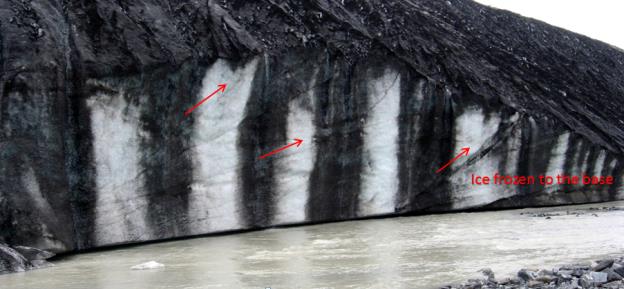Chapter 17 Summary
The topics covered in this chapter can be summarized as follows:
17.1 Types of Glaciers
The two main types of glaciers are continental glaciers, which are very large and cover large parts of continents (e.g. the Antarctic Ice Sheet), and alpine glaciers, which occupy mountainous regions. Ice accumulates at higher elevations — above the equilibrium line — where the snow that falls in winter does not all melt in summer. In continental glaciers, ice flows outward from where it is thickest. In alpine glaciers, ice also flows from thicker to thinner regions in the glacier, obeying the law of gravity. At depth in glacier ice, flow occurs through internal deformation, but glaciers that have liquid water at their base can also flow by basal sliding. Crevasses form in the rigid surface ice in places where the lower plastic ice is changing flow rate or shape as it moves over the underlying topography.
17.2 Glacial Erosion
Glaciers are important agents of erosion. Continental glaciers tend to erode land surface into flat plains, while alpine glaciers create a wide variety of different erosional features. The key feature of alpine glacial erosion is the U-shaped valley. Arêtes are sharp ridges that form between two valleys, and horns form where a mountain is glacially eroded on at least three sides. Since tributary glaciers do not erode as deeply as main-valley glaciers, hanging valleys exist where the two meet. On a smaller scale, both types of glaciers form roche moutonnées, d glacial grooves, and striae.
17.3 Glacial Deposits
Glacial deposits form as materials are transported and deposited in a variety of different ways in a glacial environment. Sediments that are moved and deposited directly by ice are known as till. Till deposits left at the edges of the glacier as it recedes are known as moraines. Till can also form features such as drumlins (oval-shaped elongated hills) and kettle lakes. Glaciofluvial sediments are deposited by glacial streams, either forming eskers or large proglacial plains known as sandurs. Glaciolacustrine and glaciomarine sediments originate within glaciers and are deposited in lakes and oceans, respectively.
17.4 Glaciations over Earth’s History
There have been many glaciations in Earth’s past, the oldest known starting about 2.4 Ga. The late Proterozoic “Snowball Earth” glaciations were thought to be sufficiently intense to affect the entire planet. The Pleistocene Glaciation was a series of glacial events over the past 2.85 Ma. The periodicity of glaciations in the Pleistocene is related to subtle changes in Earth’s orbital characteristics (Milankovitch cycles), which are exaggerated by positive climate feedback processes. North America was most recently glaciated during the Wisconsinan Glaciation, from 150-50 ka.
Review Questions
1. What feature of a continental glacier causes it to flow?
2. Explain how alpine glacier ice flows.
3. What does the equilibrium line represent in a glacier?
4. Which of the following is more important to the growth of a glacier: very cold winters or relatively cool summers? Why?
5. Describe the relative rates of ice flow, and why the rate distributions are the way they are, within the following parts of a glacier: (a) the bottom versus the top and (b) the edges versus the middle.
6. Figure 17.40 shows thrust faults in the leading edge of the Athabasca glacier in Alberta. Find the thrust faults in the glacier. Note: they are harder to distinguish in this image than in Figure 17.12 because they don’t have sediments along the faults.

7. What ice conditions are necessary for basal sliding to take place?
8. What sources of heat can lead to melting and/or water accumulation at the base of a glacier?
9. Why do glaciers carve U-shaped valleys, and how does a hanging valley form? How is a river valley different than a glacial valley?
10. A horn is typically surrounded by cirques. What is the minimum number of cirques you would expect to find around a horn?
11. A drumlin and a roche moutonnée are both streamlined glacial erosion features. How do they differ in shape? How can you determine the direction of glacial flow from their shapes?
12. What are drop stones, and under what circumstances are they likely to form?
13. What types of glacial sediments are likely to be sufficiently permeable to make good aquifers?
14. Why are the Cryogenian glaciations called Snowball Earth?
15. Earth cooled dramatically from the end of the Paleocene until the Holocene. Describe some of the geological events that contributed to this cooling.
16. When and where was the first glaciation of the Cenozoic?
17. Describe the extent of the Laurentide Ice Sheet during the height of the last Pleistocene glacial period.
18. Four examples of glacial sediments are shown in Figure 17.41 below. Describe the important characteristics (e.g., sorting, layering, grain-size range, grain shape, sedimentary structures) of each, and give each a name (choose from glaciofluvial, glaciolacustrine, lodgement till, ablation till, and glaciomarine).


